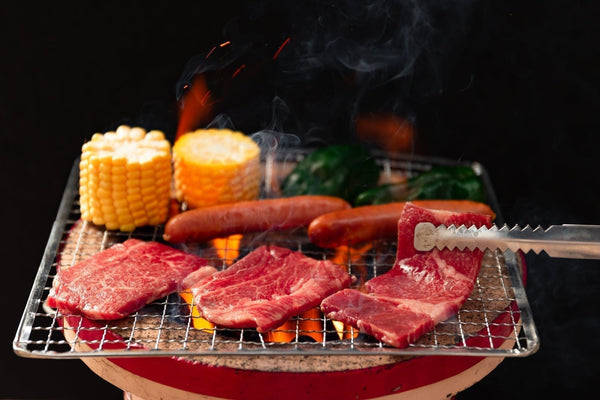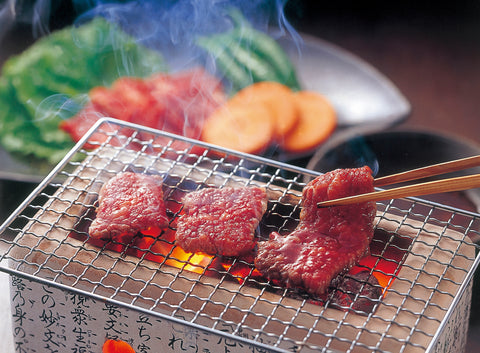
Jump to:
In Japan, hibachi literally means “fire bowl” and originally referred to a charcoal heater used for warmth, not for cooking.
Over time, the term was adopted overseas and came to describe restaurants where chefs cook meals on flat grills right in front of guests. However, this performance-based style is actually known as teppanyaki in Japan.
So while hibachi-style food is inspired by Japanese cuisine, the modern “hibachi restaurant” experience is an American invention.
What makes this type of food so tasty? It’s the combination of high heat, garlic, butter, soy sauce, and fast cooking that locks in flavor. When cooked over a charcoal grill like a shichirin, it also takes on a delicious smoky, umami-rich depth.
Read on to learn more about the differences between hibachi, teppanyaki, and shichirin.
What Is Hibachi?

First and foremost, it's important to note that 'Hibachi' carries different meanings in Japan and overseas. In its Japanese context, 'Hibachi' literally translates to 'fire bowl.'
Originally, it referred to a traditional cylindrical heating device with an open-topped pot, primarily used for heating hands and boiling water during the Heian period (794-1195).
Hibachi heating devices can hold charcoal, allowing them to stay warm for quite some time. Interestingly, at that time, they weren't even considered cooking devices.
It wasn’t until around 1800 that Hibachi were used as heating devices to grill meat, because yes! Fire cooks things and makes them taste better!
On the other hand, what many foreigners think of as 'Hibachi' is actually closer to Teppanyaki. Overseas, 'Hibachi' restaurants often offer an Americanized style of cooking, inspired by traditional Japanese Teppanyaki, but still referring to themselves as Hibachi restaurants. Confusing, isn't it? Keep on reading, because we’ll explain what Teppanyaki is in the next section of this article, but for now let’s stick with Hibachi.
So yes, Hibachi in its traditional Japanese context and Hibachi overseas, which are also commonly referred to as ‘Japanese Steakhouses’ are indeed not the same thing.
Hibachi vs Teppanyaki vs Shichirin: What's the Difference?

In a nutshell:
|
Term |
Japanese Meaning |
Usage in Japan |
Usage Overseas |
|---|---|---|---|
|
Hibachi |
"Fire bowl" (charcoal heater) |
Used as a heater, not typically for cooking |
Misused to refer to teppanyaki-style cooking |
|
Teppanyaki |
Iron plate grilling (teppan = iron plate, yaki = grill) |
Restaurant-style flat iron grilling (steak, okonomiyaki, etc.) |
Popular for show-style grilling in restaurants |
|
Shichirin |
Small charcoal grill (portable) |
Used for tabletop BBQ like yakiniku |
Rarely known or distinguished from hibachi |
More details:
Let’s delve a little bit more into the topic of American Hibachi and how it may or may not differ from Japanese Teppanyaki. So now we know that Hibachi restaurants overseas are typically not referring to Hibachi as it is in Japan, they are probably referring to Teppanyaki. Teppanyaki is a Japanese cooking style that uses a large iron grill to prepare food. In Japanese “teppan” means iron plate and “yaki” refers to grilling or pan frying.
In Japan, foods commonly cooked in ‘teppanyaki style’ are steak (like wagyu), yakisoba, and okonomiyaki. In overseas Hibachi restaurants (that are really cooking teppanyaki style), it is common to see foods such as steaks, grilled shrimp, and even fried rice being cooked up. You might often equate American Hibachi to those restaurants that cook in front of you.

In simple terms, the heating devices that people refer to in Japan are ‘Hibachi’, but Hibachi with a thin wire grill on them that are used for cooking are called ‘Shichirin’ in Japan. So now, what are the differences between Shichirin and Teppanyaki? One of the biggest differences between Shichirin and Teppanyaki is that Teppanyaki is cooked on a flat iron surface, and is usually heated with propane. Hibachi, on the other hand, uses what is known as ‘Shichirin’ which has an open grate design. They are heated by burning charcoal or using a gas flame.
Shichirin is a charcoal grill that is unique to Japan and is used with Hibachi cooking devices for Japanese bbq. Shichirin are great for grilling meat and vegetables which is why you’ll commonly see them used in Japanese yakiniku restaurants.
Yakiniku & Japanese Grilling

Now that we’ve covered what Hibachi actually is, the difference between Hibachi and Teppanyaki, and explained what Shichrin is, let’s talk a bit about Japanese grilling, or yakiniku. So we now know that Hibachi and Shichirin can be used and are often used for grilling in Japan. But why?
Unlike ordinary barbeque grills, Shichirin grills (also often called Hibachi grills) are thought to make the ingredients taste more delicious. This is due to the design of Shichirin; most Shichirin grills have a hollow center which allows you to put charcoal and some sort of air vent or water inside to prevent smoke output. So less smoky hassle and tastier ingredients!
Interested in enjoying traditional Japanese BBQ at home? Be sure to check out our Japanese BBQ products and this portable Shichirin!
Is Hibachi Japanese?

What do you think about Hibachi? Did you know that the styles of Hibachi and the West were different? Have you ever tried Hibachi cuisine in Japan? We’d love to hear in the comments below.


0 comments